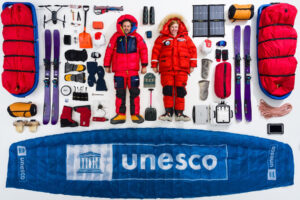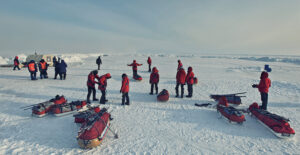You can’t imagine Amundsen or Shackleton complaining about chafed thighs during a polar trek. But in recent years, Instagram is awash with gory photos showing what Antarctic travelers have had to endure. Victims are often, though not always, women.
In truth, this isn’t just chafing. Had the great polar explorers of old had such a terrible affliction, they would have mentioned it somewhere, tough though they were.
What is it? And why the Antarctic, in particular? Lots of people ski across Greenland and elsewhere in the Far North and don’t seem troubled by it.
I’ve done many sledding expeditions in the Arctic and neither I nor my partners have ever had it. Or maybe I’ve had a mild case without realizing it. For most of those expeditions, I’ve used synthetic base layers. After merino became popular, I tried it on colder trips, since merino is a little warmer than the same thickness of synthetics. After two or three weeks, a rash began to form on my legs. At this point, I changed to my backup synthetic underwear, and the rash went away. This happened on two expeditions.
I think the first time I saw real polar thigh was when two Australians, James Castrission and Justin Jones (Cas and Jonesy), did a three-month Antarctic trek in 2011-2. They documented it in their entertaining film, Crossing the Ice. One of them developed a gory, raw thigh and showed it in the film.

Polar thigh. Photo submitted by Lars Ebbesen
Merino for three months
They had a merino sponsor, and considering my own small experience with a merino rash, I assumed that this was due to wearing wool underwear for three months. Likely they didn’t have synthetic backups or — as novice polar travelers — didn’t draw the connection between the ailment and their underclothing. Merino is very comfortable, but few people have worn a single piece of long underwear for two or three months, never taking it off, for us to know whether the salt or some bacterial buildup in that natural fiber causes a skin irritation that can worsen into polar thigh.
To better understand, I asked a who’s who of polar travelers and guides, including Borge Ousland, Richard Weber, Eric Larsen, Eric Philips, Erik Boomer, and Lars Ebbesen. They didn’t all agree, but two theories emerged: that it had something to do with wool and that it was a kind of infected frostbite.

An advanced case of polar thigh. Photo submitted by Lars Ebbesen
Weber wears only synthetics
Richard Weber is one of the proponents of the wool theory and has long insisted that his clients only wear synthetics. “I believe it is caused by wool underwear that does not breathe properly, in combination with waterproof/breathable wind pants in cold weather,” he says. “I suspect it is some bacteria going crazy.”
He adds: “I have never had it because I always wore thin synthetic underwear and breathable wind pants. But some Russians got it a bit on Polar Bridge [the 1988 Russian-Canadian expedition across the Arctic Ocean], as they wore very thick wool underwear.”
Weber says that on his last South Pole trip, one of his female clients wore wool, against his strict instructions. “She started to get [polar thigh], switched to synthetics, and it went away,” he said, echoing my experience.
Larsen: Antarctica both warmer and windier
Eric Larsen agrees with Weber. “I guided my first South Pole trip in 2008 and we were talking about it then,” he said. “It’s definitely more of an Antarctic than an Arctic phenomenon. I believe it’s because it’s both warmer and windier in Antarctica.”
Larsen believes that wool might be a factor not because of rubbing or chafing but because wool doesn’t wick moisture away from the skin as synthetics do. Like Weber, Larsen always wears synthetic base layers and has never had the condition.
“In my opinion,” adds Larsen, “the mechanism of polar thigh is that your thighs get too cold, but without a lot of nerves, you don’t feel it much. [Then you] get some sort of cold damage. This is exacerbated if the skin is wet from bad moisture management. As that skin becomes damaged, it itches, you scratch it, it gets infected, it’s not clean, it gets cold damaged again, you sweat too much…”
“This happens in Antarctica more because it’s so much windier and you’re basically skiing into a headwind all the time. It’s also warm, and people don’t do a good enough job with ventilation.”
Extra weight
Eric Philips thinks that merino may contribute to polar thigh but admits that he isn’t sure. “I have had clients with polar thigh, and my daughter gets it,” says Philips. “It seems to be more prevalent in women and people with a higher proportion of fat.”
Philips recalls that Jon Muir, one of his partners on a 1998 South Pole expedition, had a mild case of it. “Jon was definitely wearing wool,” he said.

Wool-wearer Jon Muir’s Antarctic rash. Photo: Eric Philips
Note that some travelers doing extremely long polar treks, including the Australians Cas and Jonesy, pack on a dozen kilos or more before their expedition, to minimize the amount of food they need to carry in their sleds. So even people who are usually thin sometimes start their expeditions with significantly higher amounts of fat than they are used to.
Borge Ousland had polar thigh himself on an early expedition, his 1995 South Pole trek.
“It was probably caused by chafing that got infected,” Ousland told ExplorersWeb. “But I think in most cases, it starts off with a frostbite that turns into a wound and eventually gets infected. When I started using longer and more insulated underwear, and was careful to avoid chafing seams, I have not had it.
“My theory is that the thighs are well insulated with fat and few blood vessels to keep the skin warm, and it’s easy to get small local frostbites there.”

A relatively mild case of polar thigh. Photo submitted by Richard Weber
Better parka design
Women have more fat on their legs, so may be more vulnerable, he suggests. Ousland’s custom-designed Norrona shell is much longer than most models, further protecting the thighs from wind and cold. Roland Krueger, the first German to go solo to the South Pole, likewise lengthened his jacket by sewing extra fabric onto it.

Roland Krueger with his extra-long parka at the South Pole. Photo submitted by Lars Ebbesen
Lars Ebbesen, the manager for Ousland’s polar outfitting company, is very familiar with polar thigh.
“It is frostbite, pure and simple,” Ebbesen insists. “It shows up on the legs in places where circulation/protection is scarce. Like the inside.”
He admits that it looks like an ordinary red rash at first, but it is almost always the beginning of frostbite.
“And this is very often where it goes wrong,” he warns. “If you do not take immediate precautions, and just think cleaning/treating the rash is the way to go, you lose very valuable time in stopping the frost injury. It gets a foothold, and there is no way back.”
He says that at the first sign of a rash, the traveler must immediately protect the area, adding insulation or even wearing down pants. If you let it advance too far, it can become an open wound.

A bad case of polar thigh. Photo submitted by Lars Ebbesen
Advanced polar thigh won’t heal in the cold
“If it gets that far, it is extremely difficult to heal in the cold,” says Ebbesen. “It usually keeps growing. Even though places like Antarctica are the most pristine and cleanest in the world, you risk getting infected. So bringing antibiotics can be life-saving.”
Given the potential for delays in rescue, the condition — if advanced enough that the infection gets into the bloodstream — can be fatal, he says. It is even dangerous after an expedition ends and the traveler is reintroduced to a warm environment. Circulation improves, and the infection can spread quickly.
To prevent polar thigh, “we at Ousland Explorers will not let anybody on the ice without PrimaLoft shorts or pants,” says Ebbesen. He points out that many polar travelers, men and women, wear down skirts these days to protect their thighs. Norwegians, he says, often wear an extra layer of Brynje, or mesh underwear, beneath their longjohns to trap air and increase warmth, yet allow moisture to wick away.
Eric Larsen agrees with that precaution: “I also wear long underwear ‘cut-offs’ — an extra pair of light long underwear cut off at the knees,” he says.
Harder for those who sweat a lot
Another important consideration: We all respond differently to cold. At -35˚C, my wife’s face actually hurts, while mine is perfectly comfortable. (A main reason why we’ve done many kayaking and backpacking expeditions together but never a sledding trek.) I perspire hardly at all while pulling a sled, while some partners are drenched in sweat. People who sweat heavily are always on the razor’s edge between freezing and sweltering. Others have a wide margin of equilibrium between the two extremes.
“Sweaters” need to be much more diligent with self-care. Bottom layers take much longer to swap out or layer than top layers, because you have to remove and replace boots and skis. I almost never change bottom layers during the day — it doesn’t matter if I’m a little warm down there, because I don’t sweat much — whereas I sometimes tweak top layers, headwear, and gloves several times an hour.
Erik Boomer admits that he’s a heavy sweater.
“I really need to vent and swap layers a lot,” says Boomer. “I get cold knees, thighs, and parts of my chest and need to keep an eye on those areas, especially on cold windy days.”
When he first did winter treks on Baffin Island, he didn’t wear enough layers on his legs.
A close call
“I got by well, but one very cold evening, I felt the beginnings of polar thigh,” he recalled. “It just felt warm and like windburn. I’m sure if I kept exposing my thighs to that, it would have developed. Now I put on puffy pants more often and wear more layers in general.”
He believes that people are moving faster these days and wearing fewer layers, and that is something to be aware of. “Even if hands and feet and nose are good, you can still get cold thighs.”

Insulated skirts are popular cross-country ski accessories and have become common for both men and women in Antarctica.
Whether due to wool, sweating, infected frostbite, or some medical condition such as cold panniculitis, polar thigh seems at least easy to circumvent:
- Although not everyone believes that wool is a contributing cause, synthetics work, so if you want to be safe, wear synthetic underwear. Or at least, have it as a backup, so you can change into it at the first sign of a rash.
- To counter the unique combination of summer warmth and icy wind in Antarctica, wear a down or synthetic skirt or an extra pair of knee-length mesh underwear.
- At the first sign of a rash, do something — better moisture management, warmer leg layers, a change of clothing — before it worsens to the point where it becomes infected. In the polar regions, some things you just tough out, but this is not one of them.






